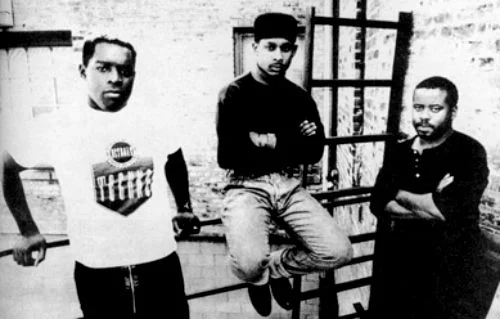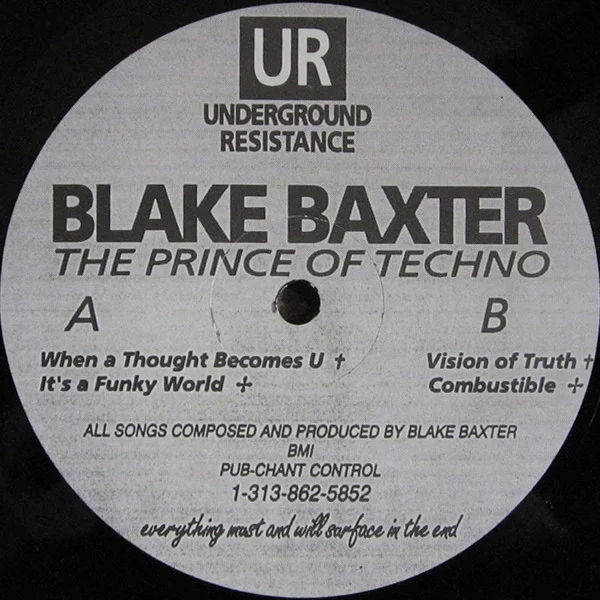A Quick and Dirty Guide to Detroit Techno
by Jay Sandwich
While techno was later adopted by many artists in many different cities all over, it was originally born in Detroit, Michigan during the 1980s.
It is a genre of EDM music and started as a fusion of funk and jazz with house and electronic. It often incorporates futuristic themes and has been seen in science fiction and noir films.
Contents

The Belleville Three
While it is inconclusive as to exactly who began the Detroit techno genre, the Belleville Three are often credited with its creation, at least partially.

The Belleville Three was made up of Juan Atkins (aka the Godfather of Techno), Kevin Saunderson (aka the Elevator) and Derrick May (aka the Innovator), three high school friends from Belleville, Michigan.
Atkins first began releasing singles with Rick Davis, a friend he met in College. The two formed a duo called Cybotron and released the single "Alleys of Your Mind" in 1981 which sold quite well. The song has an undeniable groove, a beat that just seems to permeate through you and sounds and vocals that sound futuristic.
Cybotron followed this up with two more singles, "Cosmic Cars" and "Clear", which won them a record label with Fantasy who released their first album, "Clear". After the release of this album, the duo split up to go their separate ways regarding their style of music.
Around this time, the three high school friends Atkins, Saunderson and May began experimenting with electronic music in their basements. They got inspiration from bands such as Kraftwerk, Yellow Magic Orchestra, Parliament, Prince and Depeche Mode.
For example, Yellow Magic Orchestra's Behind The Mask was an influential track.
The three would listen to these bands in the comfort of their own home, as opposed to hearing them in a dance club. This greatly changed the experience for them. May stated, "We never took it as just entertainment, we took it as a serious philosophy." After listening to these bands, Atkins was inspired to buy a synthesizer.
When Atkins learned how to DJ, he taught May and Saunderson as well. Both Atkins and May then began to DJ on Detroit's party circuit under the name Deep Space Soundworks. The Belleville Three were also recording record mixes at this time.
On a trip to Chicago, the Belleville Three experienced the Chicago house movement that was taking place there. It was the Chicago house genre mixed with the electronic and mechanical influences of their favourite bands like Kraftwerk that created such a unique style of music by the Belleville Three.
Their music reflected the post-industrialist mood of Detroit in the 1980s. They were also quite interested in futuristic ideas like the advancements of technology and machines.
Atkins also released his own single, "No UFOs" in 1985 using his psuedonym, Model 500. It was released under his own record label, Metroplex. May and Saunderson also recorded their own music on Metroplex as well.
We can't mention Rick May without mentioning his most accomplished track, entitled "Strings of Life" and released in 1987 under his pseudonym Rhythim is Rhythim. Contrary to the other techno music going on in Detroit at the time, in this track May filled the song with lively synthetic string arrangements.
"Strings of Life" was quite a pleasant and interesting surprise to other artists in the techno scene and became especially big in Britain. It is true that when you listen to this song, it has a certain enlivened energy, sounding rich and colourful and elated. No wonder Rick May was nicknamed "The Innovator".
Futurism and Afrofuturism
One big theme of Detroit techno was that it strived to bring tidings of the future, much like science fiction has always strived to do. In an article from The Wire, a British avant-garde music magazine, Mike Shallcross wrote, "What distinguishes Detroit Techno from its European variants is the way it more directly works the interface of funk and futurism."
As techno grew in Detroit, it created certain club scenes. This was when the "Prep Clubs" were created, attended by suburban blacks in Detroit and less accessible to the lower class. These prestige clubs had fancier dress codes and often adopted parts of European culture, because to them it was seen as "high class".
These Prep Clubs created tensions between the suburban blacks and the black people living in the poorer urban parts of Detroit.
Afrofuturism is a cultural aesthetic and philosophy that deals with the expanding interchange of Africans and technology, exploring the present-day difficulties of black people as well as their history.
Technology was especially relevant to the people of Detroit, because the rise of robotics robbed them of their industry. This was the climate that the Belleville Three had grown up in; witnessing technology's advancements and seeing the changes it brought on to their city.
The Belleville Three contributed to this Afrofuturism with their music. They took technology and used it to their advantage, making tracks in their basements by manipulating machines. They didn't use any fancy equipment, but rather, experimented with what they had. The sound they made was futuristic and touched on the feeling of "otherness".
Until this point there was no club for the techno scene to come together as one. For this reason, artists George Baker and Alton Miller created The Music Institute, a techno club in downtown Detroit. Here, the Belleville Three DJed with other pioneers of the genre such as Eddie "Flashin" Fowlkes and Blake Baxter.

The Music Institute helped unite the underground techno family and also contributed to the second wave of Detroit techno, as more young artists became inspired by the Belleville Three and other artists playing there such as Blake Baxter and Chez Damier. The second wave of artists included Jeff Mills, Carl Craig and Octave One.
International Growth of Detroit Techno
In 1988, the Belleville Three were approached by music entrepreneur Neil Rushton to release their music in the UK. They chose the word "techno" for their music, a term that Atkins had been using for a long time already ("Techno City" was one of his early singles).
Later in 1988 the album "Techno! The New Dance Sound of Detroit" was released in the UK to great success. The album was compiled by Neil Rushton and Derrick May. It was this album that encouraged the term "techno" to be used as a label for that particular genre of music.
Detroit Techno Artists You Should Listen To
In addition to the Belleville Three, there are some other big names in Detroit Techno that every techno fan should listen to.
Blake Baxter was labelled by Allmusic and "perhaps the most underrated figure" in the early Detroit techno days.
Baxter first began mixing records in the mid-1980s, releasing records on labels such as DJ International, KMS Records and Underground Resistance, which released his EP "The Prince of Techno" in 1991.

Speaking of Underground Resistance, they were an important musical collective, with a grungy aesthetic and political messages behind their music. Underground Resistance was started by Jeff Mills and "Mad" Mike Banks in the late 1980s.
They strove to promote political activism through their music. Below is their single "Fuel For the Fire - Attend the Riot". The name alone is suggestive of political activism, and the music is empowering.
The group rejected everything mainstream or commercialized. They wanted the techno genre to remain independent. Through their music they tried to give a different identity to the young black men of urban Detroit, rejecting the hard, violent stereotype and instead portraying a new image. Their songs promoted a sense of self-exploration and the attitude to improve yourself and your circumstances.
Their albums include "Revolution for Change", "Electronic Warfare", and "Interstellar Fugitives" throughout the 1990s, as well as "A Hitech Jazz Compilation" in 2005.
Carl Craig was another big name in Detroit techno, emerging in the second wave of techno artists in Detroit. Craig used a wide variety of genres to inspire his particular style of techno, such as soul and jazz.
If you are unfamiliar with the name Carl Craig, maybe you'll know him by one of his many aliases: BFC, Psyche, Paperclip People, 69, Designer Music and Innerzone Orchestra. His best-known track was released under this last alias; the track was "Bug in the Bassbin", which is thought to have influenced the evolution of bass and drum. Have a listen and you'll notice the unique drum batterns, unlike the typical beat of most techno songs.
Craig also collaborated with NYDJ Patrick Picasso and the two made a very successful album. Some other of his well-known albums include "Landcruising" and "More Songs About Food and Revolutionary Art" under his own name, "The Sound of Music" under 69, and "Programmed" under Innerzone Orchestra.
Octave One did not consist of one but many members. It was mostly made up of two brothers, Lenny Burden and Lawrence Burden, but they were often joined by their three other siblings, Lorne Burden, Lynell Burden and Lance Burden (how did their mother keep all their names straight?)
Octave One debuted on Derrick May's record label with their single "I Believe", which was also included on the compilation album "Techno 2: The Next Generation" in 1990.
Conclusion
In conclusion, Detroit techno was an important genre that began in the 1980s, largely sparked by the Belleville Three. The genre gave a voice to the black population of Detroit, created a musical community and expressed their identities. It also dealt with themes of technology and futurism. Detroit techno continues to inspire more young artists today, and the techno scene in Detroit is still going strong.
 |
 |
 |
 |

About Jay Sandwich
Jay is an ex-shred guitar player and current modular synth noodler from a small town somewhere. Quote: “I’m a salty old sandwich with a perspective as fresh as bread.” No bull.
Leave a Reply
Check for FREE Gifts. Or latest free acoustic guitars from our shop.
Remove Ad block to reveal all the rewards. Once done, hit a button below
 |
 |
 |
 |